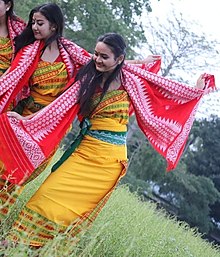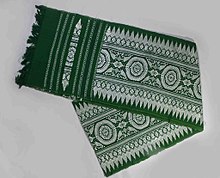Boro culture
For long, the Boros have been farmers living in an Agrarian society[4] with a strong tradition of fishery, poultry, piggery, with rice and jute cultivation, and betel nut plantation.
Moreover, there are about 15/18 kinds of Kherai Dance like Ranachandi, Gorai Dabrainai, Dao Thwi Lwngnai, Khwijema hannai, Mwsaglangnai.
[citation needed] Among the many different musical instruments, the Boros use: Kham, Siphung, Serja, Jotha, Jabsring, Khawang, Bingi, Rege.
Siphung : This is a long bamboo flute with only five holes rather than six as the north Indian Bansuri would have and is also much longer than it, producing a much lower tone.
[5] Rice is the main staple food[6] but eaten with non-vegetarian dishes like fish or pork.
[citation needed] Narzi: It is a bitter gravy made from dried jute leaves.
[7] The angkur contains a traditional recipe of herbs (dhapat tita, dhan, senikuthi, agara)[8] that provide Jou gishi with its distinctive flavour, colour, and ethno-medicinal properties and the consumption of Jou gishi is sometimes ritualistic on the occasions of festivals, marriages and communal gatherings.
[9] Bwisagu is the most cherished springtime festival celebrated by the Boro people at the advent of the new year.
In winter, it is wrapped around the neck to warm up the body and generally used in the performance of the Boro dance.
At the time of the war, the Boro women would weave Aronai within a single night and present it to the warriors as they set out for the battlefield.
It is worn to cover the whole body from the chest region to the legs by wrapping one round at a time over the waist.
They are - Matha Dokhona (bidon) is actually plain, without any Agor (design); worn while worshipping God.
Nowadays, the Boro women wear different colours of blouse with Dokhona to cover their upper bosom.

